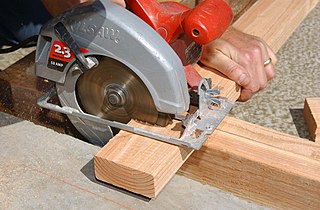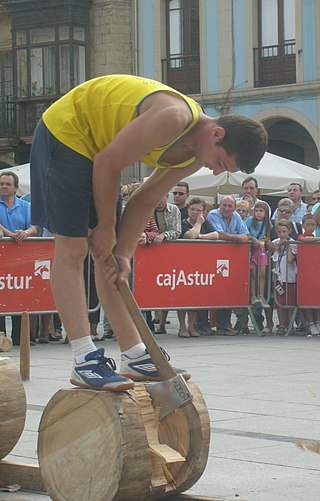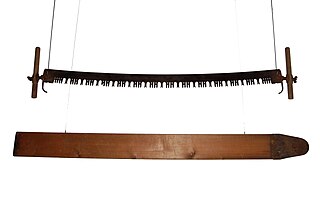
Lumberjacks are mostly North American workers in the logging industry who perform the initial harvesting and transport of trees for ultimate processing into forest products. The term usually refers to loggers in the era when trees were felled using hand tools and dragged by oxen to rivers.

A circular saw is a power-saw using a toothed or abrasive disc or blade to cut different materials using a rotary motion spinning around an arbor. A hole saw and ring saw also use a rotary motion but are different from a circular saw. Circular saws may also be loosely used for the blade itself. Circular saws were invented in the late 18th century and were in common use in sawmills in the United States by the middle of the 19th century.

A chainsaw is a saw that cuts with a set of teeth attached to a rotating chain driven along a guide bar. Modern chainsaws are used in activities such as tree felling, limbing, bucking, pruning, cutting firebreaks in wildland fire suppression, harvesting of firewood, for use in chainsaw art and chainsaw mills, for cutting concrete, and cutting ice. Precursors to modern chainsaws were first used in surgery, with patents for wood chainsaws beginning in the late 19th century.

Woodsman is a competitive, co-ed intercollegiate sport in the United States, Canada and elsewhere based on various skills traditionally part of forestry educational and technical training programs. In North America, the sport currently is organized in five regional divisions: northeastern, mid-Atlantic, southern, midwestern, and western.

Chaps are sturdy coverings for the legs consisting of leggings and a belt. They are buckled on over trousers with the chaps' integrated belt, but unlike trousers, they have no seat and are not joined at the crotch. They are designed to provide protection for the legs and are usually made of leather or a leather-like material. Their name is a shortened version of the Spanish word chaparajos. Chaparajos were named after the chaparral, from which they were designed to protect the legs while riding on horseback. Like much of western American horse culture, the origin of chaparajos was in the south of Spain, from which it then passed on to the part of New Spain that later became Mexico, and has been assimilated into cowboy culture of the American West. They are a protective garment to be used when riding a horse through brushy terrain. In the modern world, they are worn for both practical work purposes and for exhibition or show use. Chaps have also been adopted for use on motorcycles, particularly by cruiser-style motorcycle riders.

A feller buncher is a type of harvester used in logging. It is a motorized vehicle with an attachment that can rapidly gather and cut a tree before felling it.

A crosscut saw is any saw designed for cutting wood perpendicular to (across) the wood grain. Crosscut saws may be small or large, with small teeth close together for fine work like woodworking or large for coarse work like log bucking, and can be a hand tool or power tool.

Woodchopping, called woodchop for short, is a sport that has been around for hundreds of years in several cultures. In woodchopping competitions, skilled contestants attempt to be the first to cut or saw through a log or other block of wood. It is often held at state fairs and agricultural shows. Participants are often referred to as axemen.

Chainsaws and chainsaw operations have specific risk control methods.

Safety practices generally recommend that chainsaw users wear protective clothing, also known as personal protective equipment or PPE, while operating chainsaws. There is general agreement worldwide on what clothing is suitable, but local jurisdictions have specific rules and recommendations.

Stihl is a German manufacturer of chainsaws and other handheld power equipment including trimmers and blowers. Their headquarters are in Waiblingen, Baden-Württemberg, near Stuttgart, Germany. Stihl was founded in 1926 by Andreas Stihl, an innovator in early chain saw production. Stihl says it is the world's best-selling brand of chain saws and the only chain saw manufacturer to make its own saw chains and guide bars. Andreas Stihl AG is a privately held company owned by the descendants of Andreas Stihl. Stihl operates the Stihl Timbersports Series.
The art of chainsaw carving is a fast-growing form of art that combines the modern technology of the chainsaw with the ancient art of woodcarving.

Workwear is clothing worn for work, especially work that involves manual labour. Often those employed within trade industries elect to be outfitted in workwear because it is built to provide durability and safety.

Felling is the process of cutting down trees, an element of the task of logging. The person cutting the trees is a lumberjack. A feller buncher is a machine capable of felling a single large tree or grouping and felling several small ones simultaneously.

The Lumberjack World Championships are held annually in Hayward, Wisconsin. The event began in 1960 and is held at the Lumberjack Bowl. There are 21 events for both men and women to compete for over $50,000 in prize money. Contestants come from the United States, Canada, Australia, and New Zealand. The events include sawing, chopping, logrolling, and climbing to test the strength and agility of over 100 competitors.
Buddy the Woodsman is a 1934 Warner Bros. Looney Tunes cartoon, directed by Jack King. The short was released on October 27, 1934, and stars Buddy, the second star of the series.
The Stihl Timbersports Series is a series of woodsman or wood chopping competitions where the athletes compete in the use of axes and saws in manners typical for lumberjacks. It was founded in 1985, and currently includes six different disciplines, with both professional and collegiate divisions. The terms 'timbersports' and 'timber sports' are trademarked by Stihl Inc.

Griffon E. Ramsey is an American chainsaw carving artist known for her pop-culture wood sculptures which have appeared at the Australian Chainsaw Carving Championships and the Butler Chainsaw Carving Invitational. Chip Chats magazine described her as a "world-famous" artist with an, "edgy and bold style" while VICE and Uproxx called her a "rock star of the art world" and noted her status as a female in a largely male-dominated field.
Stirling Hart is a Canadian professional lumberjack.

Ferry Svan is a Swedish professional woodchopper and logging sportsman, and the son of champion skier Gunde Svan. He is the first Swedish person to compete in a World Championship in logging sports, the first Swede to win a World Championship, and the youngest person to compete in logging sports as a Senior athlete. He has previously held four Swedish national records. He competes in the Stihl Timbersports Series.

















